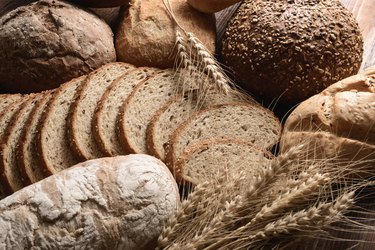
Whole grains are an important part of a balanced diet. However, looks can be deceiving — a brown-colored bread doesn't mean that it's made from whole grains.
In fact, brown bread is often a mixture of white flour and whole-wheat flour with added ingredients for color, such as caramel. If you're looking for whole-wheat bread, take a good look at the nutrition label and ingredients list for assurance that your bread is actually made from whole-wheat flour.
Video of the Day
Video of the Day
The Importance of Whole Grains
Bread is bread, right? Not quite — bread made from 100 percent whole-wheat flour contains all the parts of wheat grain, including the bran, germ and endosperm. The bran, or outer layer of the seed, is rich in vitamins and fiber, while the germ contains vitamin E, protein and fat. The endosperm, or kernel, contains most of the wheat's protein and carbohydrate content.
During processing, such as what's done when brown bread or white bread is made, the bran and germ layers are removed. Therefore, the ingredients in brown bread are stripped of many nutrients. Even after "enriching," brown bread contains less fiber and fewer vitamins.
Nutritional Content
One slice, or about 32 grams, of commercially prepared whole-wheat bread contains approximately 81 calories, though that number will differ based on the brand you buy.
Whole-wheat bread contains a little more than 1 gram of fat, 13 grams of carbohydrates, 2 grams of dietary fiber and and less than 1.5 grams of sugar. Whole-wheat bread contains no cholesterol and 4 grams of protein, according to United States Department of Agriculture's food database.
The calorie composition of brown bread varies with the brand and the ingredients used. An example of a slice of generic brown bread, approximately 34 grams, contains 90 calories with 1 grams of fat. Brown bread contains 16 grams of carbohydrates per slice, along with 2 grams each of dietary fiber and sugar, as well as 3 grams of protein.
Vitamins and Minerals
United States regulations stipulate that white flour must be fortified with B vitamins and iron to replenish the loss during the refining process. Whole-wheat bread, in addition to being rich in B vitamins thiamine, riboflavin, niacin, pantothenic acid and vitamins B-6 and B-12, is a good source of folate, necessary for the prevention of birth defects.
Whole-wheat bread also contains vitamins E and A. Nutrition in brown bread depends on the type of flour used and the degree of refinement. On average, whole-wheat bread contains up to 300 percent more zinc, 40 percent more iron and more magnesium, manganese and phosphorus than brown bread made with refined flour.
Read more: What Are Ingredients in Wheat Bread?
- University of Michigan Integrated Medicine: Healing Foods Pyramid
- U.S. Department of Agriculture: Full Report (All Nutrients): 45109206, BROWN BREAD, UPC: 076057001789
- U.S. Department of Agriculture: Basic Report: 18075, Bread, whole-wheat, commercially prepared
- Health Ambition: White Bread vs. Brown Bread